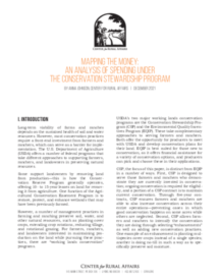Long-term viability of farms and ranches depends on the sustained health of soil and water resources. However, most conservation practices require a front-end investment from farmers and ranchers, which can serve as a barrier for implementation. The U.S. Department of Agriculture (USDA) offers a number of federal programs that take different approaches to supporting farmers, ranchers, and landowners in preserving natural resources.
Some support landowners by removing land from production—this is how the Conservation Reserve Program generally operates, offering 10- to 15-year leases on land for removing it from agriculture. One function of the Agricultural Conservation Easement Program is to restore, protect, and enhance wetlands that may have been previously farmed.
However, a number of management practices in farming and ranching preserve soil, water, and other natural resources, such as planting cover crops, extending crop rotations, reducing tillage, and rotational grazing. For farmers, ranchers, and landowners interested in maintaining production on the land while pursuing these practices, there are “working lands conservation” programs.
Policy
Farm and Food


